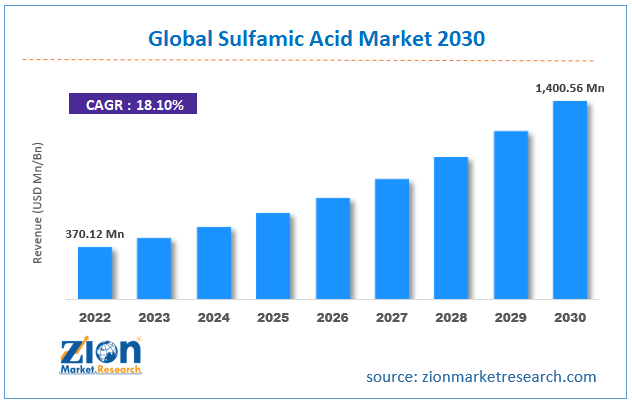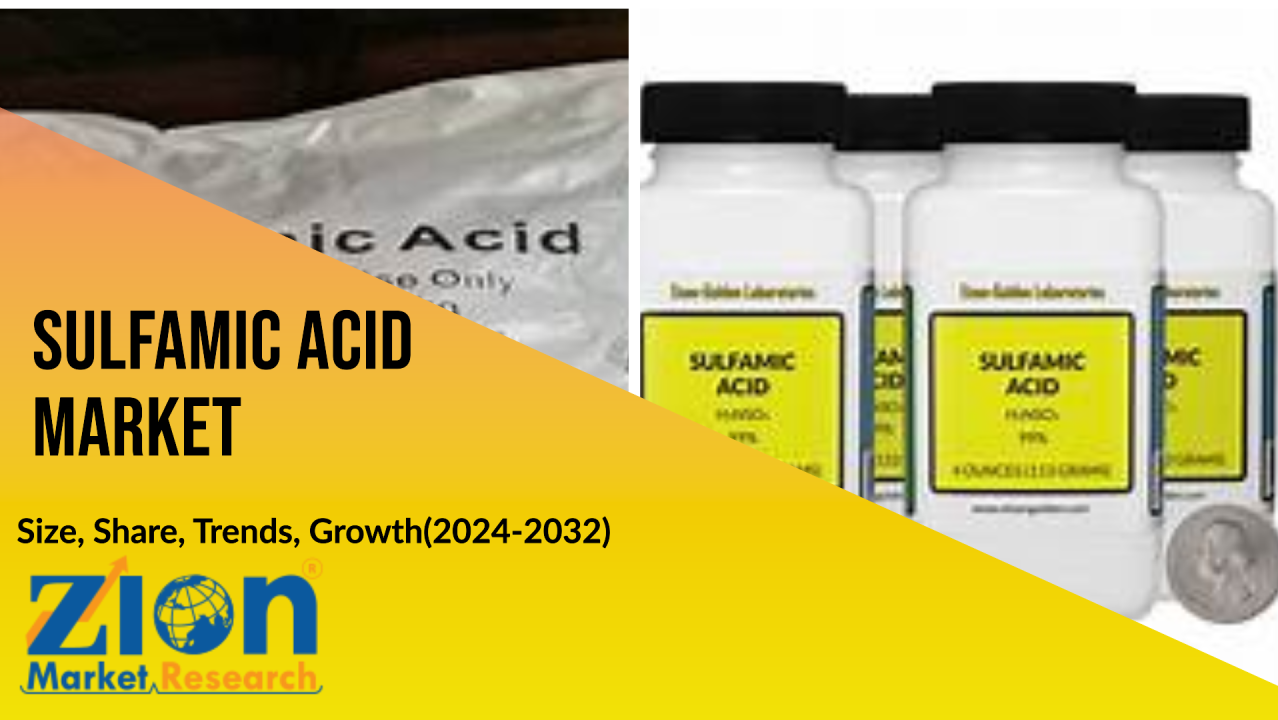The market for sulfamic acid was estimated to be valued at USD 370.12 million in 2024, and it is expected to increase at a compound annual growth rate (CAGR) of around 18.10% between 2024 and 2032, reaching a total market value of USD 1400.56 million by 2032.
Introduction
Sulfamic acid (H₃NSO₃) is a versatile compound used across a wide range of industries, including cleaning, water treatment, metal finishing, and food processing. It is a powerful acid cleaning agent and descaler, which makes it a valuable chemical for removing limescale, rust, and mineral deposits. As the demand for efficient, eco-friendly cleaning agents rises, the global sulfamic acid market is experiencing steady growth. This article explores market trends, key drivers, major applications, and the future outlook for the sulfamic acid market.
Overview of the Sulfamic Acid Market
Amidosulfuric acid, sulfamidic acid, amino sulfonic acid, and amino sulfonic acid are some of the other names for sulfamic acid. H3NSO3 is the chemical formula for sulfamic acid. It is a water soluble, colorless chemical.

Sulfamic acid has many uses, such as cleaning oxidized surfaces, sterilizing metal components and water, flushing boilers, eliminating nitrite from tobacco, and more. It is also a raw ingredient for pesticide intermediate.
Sulfamic Acid Market: Expanding Segments
The personal care industry’s expanding demand and the growing need for sulfamic acid in various industrial applications are the main drivers propelling the sulfamic acid market. One of the main causes driving the market’s expansion is consumers’ growing expenditure on cosmetics.Positive market expansion in the personal care industry is having a beneficial effect on the sulfamic acid market. Since sulfamic acid is thought to be safe to use in personal care products, demand for the product is rising. Sulfamic acid is a water-soluble chemical that finds increasing application as a cleaning agent in the industrial sector. Government regulations and the possibility of cancer from long-term sulfamic acid use are the main obstacles to the market’s expansion.
 Sulfamic Acid Market
Sulfamic Acid Market
Market for Sulfamic Acid: Report Scope
 Sulfamic Acid Market
Sulfamic Acid Market
Sulfamic Acid Industry: Division
Sulfamic acid is divided into three segments in the global market: form, application, and end-user industry. The worldwide market is divided into liquid, crystal, powder, and other forms based on the form. The sulfamic acid market is divided into several segments based on the applications it is used for, such as electroplating and electro-refining, sulphation and sulphation, dyes and pigments, paper & pulp manufacture, plastic, chlorine stabilization, and others. The market is segmented into medicines, food and beverage, cosmetics, agriculture/animal feed, and other end-user industries.
Sulfamic Acid Market: Geographical
Perspective Sulfamic acid is becoming more and more in demand in the paper and cosmetics industries in the North American region. The Asia Pacific region contributes a sizeable portion of the industry. Due to the presence of numerous significant market players and medium-sized sulfamic acid manufacturing businesses, China is the country driving the demand for sulfamic acid in the Asia Pacific region. The demand for sulfamic acid in the Asia Pacific area is anticipated to be driven by the growing chemical sector. The market for sulfamic acid is being driven by the rising demand for cosmetics in North America’s wealthy nations. The personal care industry’s need for sulfamic acid has increased the market’s expansion in Latin America.
Chemical Properties and Applications
Sulfamic acid is a water-soluble, crystalline compound that combines the properties of a strong acid with relatively low corrosivity compared to other strong acids. Its wide-ranging applications include:
- Cleaning Agents and Descalers: Sulfamic acid is commonly used in industrial and household cleaners for its excellent descaling and cleaning properties. It effectively removes limescale, rust, and mineral deposits from metal surfaces, making it essential in industrial equipment maintenance.
- Water Treatment: Sulfamic acid is widely used in water treatment plants to control pH levels and prevent scale formation. Its ability to remove hard water deposits enhances the efficiency of cooling towers, boilers, and other water-based systems.
- Metal Finishing and Electroplating: In the metal processing industry, sulfamic acid serves as a corrosion inhibitor and cleaning agent, ensuring high-quality finishes for metals used in electronics, automotive, and construction sectors.
- Food Industry Additives: The compound is utilized as a food additive, specifically in sugar refining, where it helps control pH and prevent sugar decomposition during production.
Market Drivers
- Growing Demand in Cleaning and Descaling Applications Sulfamic acid’s effectiveness as a cleaning and descaling agent, coupled with its lower environmental impact compared to traditional cleaners, is driving demand across industries. The chemical is widely used in household, industrial, and institutional cleaners, further expanding its market reach.
- Expansion of Water Treatment Infrastructure The rise in global water scarcity and the need for efficient water management have increased the demand for sulfamic acid in water treatment applications. The chemical’s role in preventing scale buildup in industrial water systems has made it a vital component in the water treatment market.
- Growth in Metal Processing and Electroplating The global rise in metal production and electroplating, particularly in industries like automotive, electronics, and construction, is boosting the demand for sulfamic acid. It is used for cleaning and passivation of metal surfaces before plating, contributing to its increased application in these sectors.
- Eco-Friendly and Sustainable Practices With growing emphasis on sustainability, industries are shifting towards eco-friendly chemicals, and sulfamic acid is gaining traction as a green alternative to more hazardous acids like hydrochloric or sulfuric acid. Its lower toxicity and reduced environmental impact appeal to manufacturers and consumers alike.
Market Trends
- Increased Adoption of Eco-Friendly Cleaning Products: Sulfamic acid is being incorporated into more environmentally friendly cleaning solutions, especially as regulatory bodies enforce stricter environmental standards. The trend toward greener products is expected to drive growth in sulfamic acid demand.
- Growth in Asia-Pacific Markets: Rapid industrialization in Asia-Pacific, especially in China and India, has created new opportunities for the sulfamic acid market. These countries are witnessing growth in sectors like manufacturing, construction, and water treatment, all of which are major consumers of sulfamic acid.
- Rising Application in Pharmaceuticals and Cosmetics: Sulfamic acid is being used in niche applications, including pharmaceutical formulations and cosmetic products, due to its safe acidifying and stabilizing properties. As the pharmaceutical industry expands, demand for sulfamic acid as an ingredient is expected to rise.
Challenges
- Health and Safety Concerns Despite its usefulness, sulfamic acid can be hazardous if not handled properly, causing skin and eye irritation. Strict safety regulations in industries using sulfamic acid, as well as potential restrictions in certain regions, can act as barriers to market growth.
- Availability of Substitutes Alternatives such as citric acid, hydrochloric acid, and other synthetic descaling agents can perform similar functions, potentially limiting the market share of sulfamic acid. Industries may opt for these alternatives depending on cost, availability, or specific requirements.
Future Outlook
The global sulfamic acid market is poised for steady growth, driven by increasing demand in sectors like cleaning, water treatment, and metal processing. The market is projected to grow at a CAGR of X% from 2024 to 2030, with significant contributions from developing economies in Asia-Pacific and the Middle East.
As industries continue to focus on sustainable practices and eco-friendly alternatives, sulfamic acid’s role in green cleaning products and water treatment processes is expected to expand. Additionally, ongoing innovations in production techniques and new applications in niche sectors like cosmetics and pharmaceuticals will further drive demand.
Conclusion
The Sulfamic Acid Market is characterized by strong growth in industrial cleaning, water treatment, and metal finishing applications. With increasing emphasis on eco-friendly alternatives, sulfamic acid is gaining recognition as a safer and more sustainable option compared to traditional acids. However, challenges such as health concerns and competition from substitutes must be addressed to ensure long-term market growth. The future looks promising as new applications and expanding industrial sectors create a positive outlook for the global sulfamic acid market.
Contact Us:
Zion Market Research212
USA/Canada Toll Free: 1 (855) 465–4651
Newark: 1 (302) 444–016611\
Web: https://www.zionmarketresearch.com/
Blog: https://zmrblog.com/
